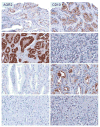Prostate cancer cell phenotypes based on AGR2 and CD10 expression
- PMID: 23348903
- PMCID: PMC3638070
- DOI: 10.1038/modpathol.2012.238
Prostate cancer cell phenotypes based on AGR2 and CD10 expression
Abstract
The combination of expression patterns of AGR2 (anterior gradient 2) and CD10 by prostate cancer provided four phenotypes that correlated with clinical outcome. Based on immunophenotyping, CD10(low)AGR2(high), CD10(high)AGR2(high), CD10(low)AGR2(low), and CD10(high)AGR2(low) were distinguished. AGR2(+) tumors were associated with longer recurrence-free survival and CD10(+) tumors with shorter recurrence-free survival. In high-stage cases, the CD10(low)AGR2(high) phenotype was associated with a ninefold higher recurrence-free survival than the CD10(high)AGR2(low) phenotype. The CD10(high)AGR2(high) and CD10(low)AGR2(low) phenotypes were intermediate. The CD10(high)AGR2(low) phenotype was most frequent in high-grade primary tumors. Conversely, bone and other soft tissue metastases, and derivative xenografts, expressed more AGR2 and less CD10. AGR2 protein was readily detected in tumor metastases. The CD10(high)AGR2(low) phenotype in primary tumors is predictive of poor outcome; however, the CD10(low)AGR2(high) phenotype is more common in metastases. It appears that AGR2 has a protective function in primary tumors but may have a role in the distal spread of tumor cells.
Conflict of interest statement
The authors declare no conflict of interest.
Figures










References
-
- Thompson IM, Pauler DK, Goodman PJ, et al. Prevalence of prostate cancer among men with a prostate-specific antigen level < or =4.0 ng per milliliter. N Eng J Med. 2004;350:2239–2246. - PubMed
-
- Yu JB, Makarov DV, Sharma R, et al. Validation of the Partin nomogram for prostate cancer in a national sample. J Urol. 2010;183:105–111. - PubMed
-
- Zhang JS, Gong A, Cheville JC, et al. AGR2, an androgen-inducible secretory protein overexpressed in prostate cancer. Genes Chromosomes Cancer. 2005;43:249–259. - PubMed
Publication types
MeSH terms
Substances
Grants and funding
LinkOut - more resources
Full Text Sources
Other Literature Sources
Medical
Miscellaneous

